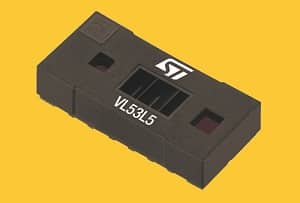Increased camera Field-of-View coverage and spatial resolution with low-power on-board processing enable new features in imaging systems
 To help an imaging system build a detailed spatial understanding of a scene, the VL53L5 (a part of FlightSense Time-of-Flight (ToF) sensors) is a product that comprises of:
To help an imaging system build a detailed spatial understanding of a scene, the VL53L5 (a part of FlightSense Time-of-Flight (ToF) sensors) is a product that comprises of:
- A 940nm Vertical Cavity Surface Emission Laser (VCSEL) light source
- A System-on-Chip sensor integrating a VCSEL driver
- Receiving array of Single Photon Avalanche Diodes(SPADs)
- A low-power 32-bit MCU core and accelerator running sophisticated firmware.
Housed in a miniature module (6.4 x 3.0 x 1.5 mm), the VL53L5 ToF sensor contains optical elements in the receive aperture that creates 64 ranging zones, unlocking a host of new features and use cases.
It integrates both transmit and receive lenses into the module design and expands the Field of View (FoV) of the module to 61-degrees diagonal. This wide FoV is especially suited to detect off-centre objects and ensure perfect autofocus in the corners of the image.
In the ‘Laser Autofocus’ use case, the VL53L5 gathers ranging data from up-to 64 zones across the full FoV to support “Touch to Focus” and many other features, which enhances smartphone/camera performance, convenience, and versatility.
Further flexibility is available via the SPAD array, which can be set to a favourable spatial resolution, where it outputs all 64 zones at up to 15fps or can be set to a favourable maximum ranging distance, where the sensor outputs 4×4/16 zones at a frame rate of 60fps.
Enhanced Autofocus
Time-of-Flight technologies have continued to build significant high-value performance improvements across a wide range of use cases including human-presence detection to control the wakeup and hibernation of laptops or monitors and laser autofocus in hybrid focusing algorithms for smartphone cameras. The autofocus feature of ST’s FlightSense sensors is embedded in most of the highest-ranking smartphone cameras.
The camera subsystem is a major factor in differentiating smartphone performance. Within the camera, the laser autofocus assures quick, accurate focusing in low-light scenes or when capturing low-contrast targets. These scenarios present tough challenges for conventional autofocus systems but are no problem for ST’s sensors.
The FlightSense also gathers the raw data collected by the SPAD array and performs post-processing, via a proprietary, embedded MCU and accelerator before transferring the ranging data to the system host over an I2C or an SPI bus. This removes the need for a specific camera interface and powerful receiver MCU and assures high-quality, high-performance operation.
“The multi-zone VL53L5 FlightSense direct Time-of-Flight sensor uses advanced 40nm SPAD production process to offer outstanding 4m ranging performance and up to 64 ranging zones that help an imaging system build a detailed spatial understanding of the scene,” said Eric Aussedat, General Manager of ST’s Imaging Division. “Delivering 64x more ranging zones than previously available, the VL53L5 offers radical performance improvement in laser autofocus, touch-to-focus, presence detection and gesture interfaces while helping developers create even more innovative imaging applications.”
The VL53L5 retains the Class 1 certification of all STMicroelectronics’ FlightSense sensors and is fully eye-safe for consumer products. The VL53L5 is in mass production with millions of units already shipped to leading wireless and computer manufacturers.







